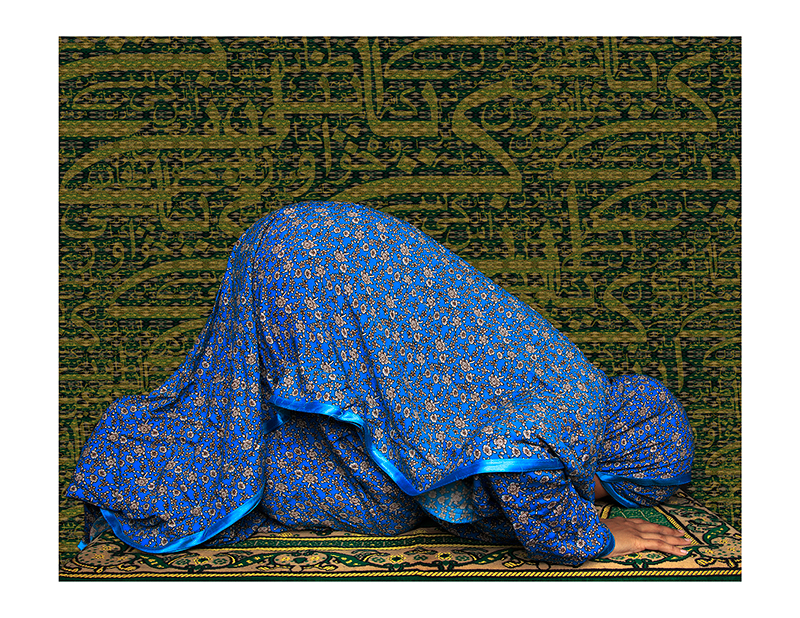Martha Díaz Adam and Visual Ethnology
Art
Photographer Martha Díaz Adam, a recent Utah State University BFA graduate in photography, has a penchant for visual ethnography. She seeks to foster understanding among cultures and understanding of underrepresented groups of people—both locally in Utah and abroad—through her photographic portraits and work. Díaz Adam shifts between documentary-style portraits and her style of fine art photography, in which part of the composition becomes imbued with patterns that she integrates as a tribute to the culture and traditions of the subject. This may take form as text or patterns found in textiles. Currently back in the Dominican Republic, Díaz Adam writes to us here about her journey as a photographer and her passion for and commitment to diversity therein.
SLUG: How did you get your start in photography?
Martha Díaz Adam: My father showed me a picture of my very first camera, a pink, analog 110 film camera. He said, “When you were 6 years old, you used to go around family gatherings taking pictures. Look at you today, a studied visual artist.” Though, consciously, when I turned 14 years old, I asked my father for a camera, and he gifted me a white digital polaroid. A year later, he asked me what I wanted for my 15th birthday. As a tradition with Latin females when turning 15, a big party is the traditional way of celebrating it. Instead, I told my father I wanted a professional camera (DSLR). This was not something usual in our culture, but a few days after winning a contest and having published my first-ever photo of a landscape in a recognized newspaper in town, my father saw this as a sign and gifted me the camera.
After obtaining my first DSLR camera, I decided to become self-taught in the field of photography. Then, four years later, I started educating myself with workshops and ended up making it not just my passion but started university studies in fine art photography in 2013.
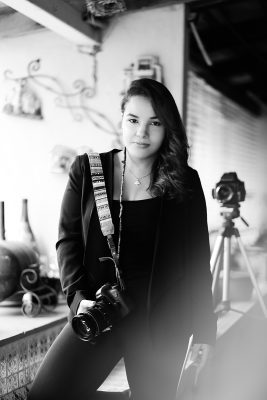
SLUG: Please describe your background in and passion for anthropology.
Díaz Adam: There are three main reasons that shaped my passion for anthropology studies.
–My grandfather and his family migrated from Lebanon; I was raised in the Dominican Republic but in between two cultures.
–The Dominican Republic, previous to its independence, was full of historical land-and-political disputes. As an outcome, we have a very mixed ancestry from our Native Indigenous, Spaniard colonizers, French colonizers and African slaves.
–The moment I left home alone to start my art studies (19 years old) in the United States, I encountered within myself questions of identity, and home stopped being a geographical location. As with me, I found many others belonging to the foreigner community in the USA, so I wanted to tell their stories.
My first encounter with anthropology was while seeking backup to support my photographic research. The only way of understanding the differences among us humans is by starting the study of our own human race. The study of cultural anthropology gave me the skills to be able to understand; after gaining this skills, I understood that my background induced my curiousness about cultural differences. I felt the need to transmit this knowledge through my visual work, to attract others with misunderstandings and to educate them.
SLUG: What attracts you to depicting diversity in your work?
Díaz Adam: Misunderstanding, oppression and the racial judgment I see every day. Our world is, everyday, a more diverse and mixed place, but it has become very judgmental toward the unknown. Many people have enclosed themselves into a small bubble full of biased statements about other cultures and ethnic groups. This is rooted, most of the time, in political, religious and historical conflicts, which have indeed happened but are also manipulated by the media and used to create hatred against other perspectives and beliefs. I intend to research cultural issues and present them in an empowered way to attract the viewer and educate them about these issues and erase false cultural stereotypes.
SLUG: What have you learned about immigrant communities in Utah through your work?
Díaz Adam: In my work, I have documented those whose roots are not from here, but are here. I use the word foreigner in order to broaden this term. Immigrants are those who came to stay permanently, despite their legal or illegal status. Foreigners are those who are coming from a country other than one’s own, not necessarily to stay permanently. From both subjects, I have learned the power of privilege. When you find yourself in another country other than your own, you lose most of your privileges. It is important to know the value of this word and to use it as a weapon for social change. Those who have more privilege in a society should use it to give voice to those who do not have it. This happens everywhere, but I saw it mostly in the United States: When you belong to a minority group, you are aware of the injustices happening in a country against those who have no voices because of their religious beliefs, sexual preferences, nationality, skin color, gender and social status.
SLUG: From the work you sent me that depicts Utah-based immigrants, what stories might you wish to share?
Díaz Adam: The day I presented my photographic research The Agony of Misconception in the UCUR 2017. I felt scared at first—exhibiting photographs is something I have been doing for a long time now, but presenting my written paper and photographic research together in front of a scholarly audience is something that presented a challenge for me. At the end of the conference, a lot of the people had questions and expressed curiosity about the subject, but the one that had more relevance to my work was a young woman asking me, “How can I unbiased myself from racial ignorance?” I answered her, “Can you spot any Muslims in the room right now?” to which she answered, “No, I cannot.” I said, “There are five male muslims in this room, dressed in Western clothes just like everyone else in here.” I also concluded answering her with, “Before this presentation you may have been uneducated about the subject and seeing these five men dressed like in my photographs in the room would have maybe make you feel uncomfortable.” My photographic research explains how today’s society bonds Middle Eastern headscarves and terrorism together, planting fear about these people at the moment they are seen wearing their traditional and distinct clothing attire, either for cultural or religious purposes. Headscarves/head covering—for females, as for males—are seen very predominantly in Eastern countries. Not everyone who uses them are Muslims, and they should not been seen as a sign of oppression but rather as a devotional act, and even as fashionable or traditional clothing attire.
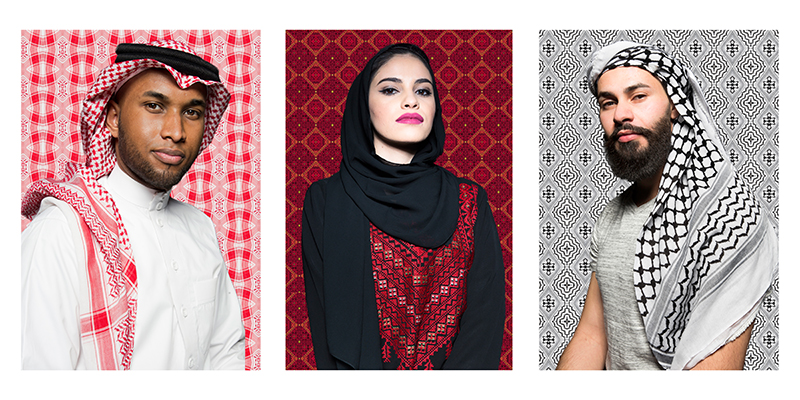
SLUG: With your upcoming work from Perú, the visual storytelling and narratives champion indigenous voices/identities and also the diversity among Peruvians through their shared nationality. What are some of your goals with this message?
Díaz Adam: To empower them. Indigenous culture is sometimes underestimated, and the truth is that these people have been fighting to maintain their culture, from the time of ancient civilizations’ to today. While I immersed myself in it, I saw how courageous and resilient these people are, and they deserve to be respected and empowered. In Perú, I found a very diverse society, from a Western-influenced society to uncontacted peoples, but the most impressive thing is to see how they coexist in peace together. There are conflicts, like everywhere in this world, but I found a very strong history that is kept alive with the everyday living. I wanted these stories to teach others that nobody should be ashamed of Indigenous culture, but rather cooperate to highlight these values and help to preserve them.
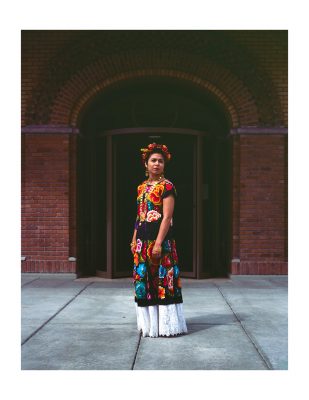
SLUG: What stories from Perú that you caught on camera would you like to share?
Díaz Adam: The relative meaning of happiness. I met people on this journey who lost everything because of environmental disaster (El Niño Phenomenon 2017), and despite that, they still looked for, in some way or another, to welcome and thank us, the group of anthropologists who helped them with a need-assessment plan. During this day, I felt that holding a camera never felt so right, to photograph and bring these stories to others. These people smiled despite all the loss and pain they had. From them, I learned that happiness is relative and that we should appreciate whatever it is that we have, whether it’s physical or spiritual.
SLUG: What are you working on in the Dominican Republic? What are your aims there?
Díaz Adam: I aim to bring back home the knowledge I’ve gathered while abroad. I intend to present and exhibit my actual body of work to Dominican society with the intention of educating about cross-cultural understanding and uncontested peoples I have photographed. After exhibiting my previous work, I will be researching and documenting human migration in the D.R., which is a current social issue in the Dominican Republic.
SLUG: What plans do you have for your upcoming travels to South America? Which countries will you visit? What are your aims here?
Díaz Adam: I will be visiting Perú, Colombia and Brazil, first co-leading and assisting in an ethnographic field school along with Dr. Michelle Grocke in Perú, on the northwestern coast and the North Andean Mountains regions. After that, I will be solo-traveling and conducting my own research in South Andean regions in Perú, the Colombian/Brazilian Amazon region and, last, departing to other regions in Colombia. During those months, I will be photographing, interviewing, gathering anthropological knowledge and creating visual ethnographic work.
SLUG: What else do you have planned in the way of visual ethnography?
Díaz Adam: I plan to create a body of work that empowers humans. Diversity is an existing fact in our society, but pluralism is not. Having a diverse community is not entirely functional if there is not pluralism, meaning cooperation despite the existing differences among us and our beliefs. As a visual artist, I want my work to speak for myself. I tried to bring social issues and cross-cultural understanding, not just to create art for the sake of art, but to educate.
We are not alone in this world—acting only on what our beliefs dictate and judging those who do not share our beliefs is a mere act of selfishness. Understanding, respecting and acknowledging cultural differences will not lead us to become like them but, rather, to coexist all together and lead us to the sought-after peace in this world.

SLUG: Are there any conceptual underpinnings that inform this/these project/s?
Díaz Adam: My foundations and personal objectives is to educate the viewer about cross-cultural understanding through my visual artworks. Conducting investigation regarding cultural heritage, traditional livelihoods, preservation of cultures, religious devotional practices, internal and external migration patterns and the empowerment of oppressed ethnic groups.
My intention with this work is to socially advocate, and to empower the only race, the human race.
SLUG: What kinds of thematic intersections have you found between your work about immigrant communities in Utah and your visual ethnography work abroad?
Díaz Adam: Cultural maintenance and cultural trading. Internally or externally, when humans migrate, they do not only carry their bodies from one country to another, they also carry their beliefs. Ideologies are not just an abstract thing; it becomes concrete with the physical representation of it, when the manifestation of culture occurs. In Utah, despite the high percentage of caucasian Americans and LDS [The Church of Jesus Christ of Latter Day Saints], there is still a large amount of foreigners or immigrants—a large amount that is really far from home yet can offer you an experience like you are in their homeland for a moment. You could have a sneak peek of their traditions and values in which they were raised, in seeing how they fight to maintain their roots while living in a foreign country. Doing ethnographic work abroad, I seek the same. I seek to see how people fight to maintain their culture. Migration is a fact in our world. It occurs internally or externally almost everywhere, and cultural trading happens with a shared or non-shared nationality.
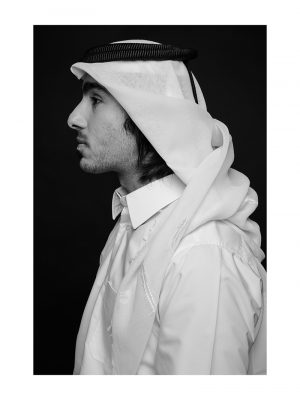
SLUG: In the Where is Home? triptych, on subjects’ figures, there are patterns of written language; and in Muslim Woman Praying behind the subject and The Agony of Misconception behind the subjects, there are patterns that seem to be extensions of the textiles that the subjects are wearing?
Díaz Adam: The written words in the Triptych Where is home? are poems written by refugees of Somalia, Syria and Palestine, where they address suffering because of the current political and cultural conflicts prevalent in their countries, and the everyday-rising numbers in the refugee community in this world.
Textiles define a very important part of our everyday culture. I extract small squares of textile patterns that are in my photographs. With them, I design new patterns. I create my own backgrounds from this small, extracted textile square. When creating my own designs, I intend to pay tribute and respect to these cultures and not to recreate an existing cultural textile pattern.
In the artwork, Surah An-Nur Ayah 31 has a background with a small extracted pattern from the prayer rug (an everyday symbol of importance for Muslims) blended together with a surah from the Qur’an that supports the concept behind the artwork.
In my photographs, these patterns have different meanings and cultural backgrounds. For example, the black-and-white headscarf worn by a man in The Agony of Misconception series is [eponymous with its title,] “The Keffiyeh,” and is a symbol of protesting against the land occupation in Palestine. Others like “The Shemagh,” the-red-and-white pattern, has become a contemporary clothing attire for Middle Eastern males, though it has its tribal and historical roots.
In [not yet published] portraits of Alonso Vazquez and Doris Paredes taken in Perú from here], the patterns I created were worked with the same creative process. The background in Alonso’s portrait is an outcome of the Northwestern coastal culture, and despite the existence of Western influence in the region, there are still persistent textile patterns from pre-Columbian civilizations. This is why we see the use of sea animals, waves and hues such as brown, yellow and blue. In the portrait of Doris, Amazonian patterns are lighter and simpler. Geometric patterns are the default style of this region.
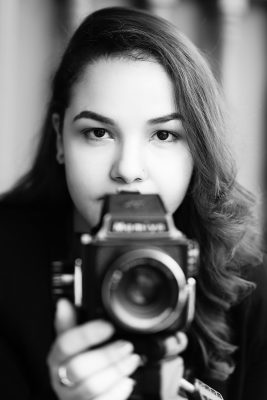
SLUG: How do you negotiate creating fine art versus documentary photography? Where do you draw that line in distinguishing between the two, if at all?
Díaz Adam: This is a battle I have to deal with every day as an artist, photographer and visual-anthropologist. I’ve had to arrange the order of my fields according to type of work I am creating.
When creating my fine art artworks, I have more freedom in creating the intended image in the post-production process. Though I am strict in the making process, I do not photograph subjects who pose to be something, rather, authentic people who are connected to the depicted concept and research. Together with the subjects, I usually insert previously created designs as backgrounds. I could also arrange the scene according to the intended outcome. In this body of work, I use the documentation of people, but I empower them as an artwork. I use anthropological research as my creative process.
When creating documentary work, I aim to depict reality the way it is—events of real life and everyday social issues that I understand must be given a voice and presented to an audience. Documentary works have other ethics that should be followed. When I take the role of visual anthropologist, I usually tend to create documentary work. The truth is, I enjoy the most when my three fields conjoin: art, photography and anthropology.
SLUG: What is your background in photography in terms of education, professional work, exhibitions, etc.?
Díaz Adam: I am a self-taught photographer who started at the age of 14. I studied in intermediate courses and earned my associate’s in contemporary photography in the Dominican Republic. I started as a BFA photography major at Utah State University in 2013 and graduated in 2017.
I am skilled in fine art photography, documentary photography and alternative photographic processes. I have experience in conducting photographic research, assisting and conducting on-assignment documentary projects, and management and use of a digital darkroom for preserving and scanning important photographic material.
In terms of exhibition, I recently had my first solo exhibit in November 2017 (title: Here, but [not] from here): a visual ethnographic documentation of Perú in Utah.
To keep up with Martha Díaz Adam’s photography and her professional career, visit marthadiazadam.com.
